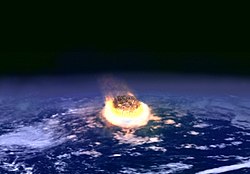Permian–Triassic extinction event

The Permian/Triassic extinction event was the largest extinction event in the Phanerozoic eon.[2][3] 57% of all biological families, 83% of all genera, 96% of all marine species became extinct. This includes many fish and the last surviving trilobites, 70% of all terrestrial vertebrates and many of the large amphibia, primitive reptiles and synapsids. It is the only known extinction event of insects. It ended the Palaeozoic era, and began the Mesozoic era.
The event forms the boundary between the Permian and Triassic periods, at about 252 million years ago.[2][4][5][6] Because so much biodiversity was lost, the recovery of life on Earth took much longer than after other extinction events.[2] This event has been described as the "mother of all mass extinctions".[7] The pattern of extinction is still unclear.[8] Different studies suggest one to three separate pulses.[5][9]
There are several proposed mechanisms for the extinctions. These include: large or multiple meteorite impacts, increased volcanism, sudden release of methane hydrates from the sea floor. Gradual changes include sea level change, oceanic anoxic events, increasing aridity, and a shift in ocean circulation driven by climate change.
One thing is probably significant. One of the largest ever flood basalt eruptions took place across the P/Tr junction. These eruptions, from 251 to 250 million years ago, produced the Siberian Traps, a huge volcanic province in Siberia. This would certainly have made the world's climate much worse, and is now thought to be the main cause of this great extinction.[3][10]
Another factor is that global sea levels were at an historic low point at the time. Lastly, it should be remembered that Pangaea was in existence: volcanic eruptions would affect all lands, continental shelves and ocean floors near the continents.
Permian–Triassic Extinction Event Media
Shell bed with the bivalve Claraia clarai, a common early Triassic disaster taxon
Sessile filter feeders like this Carboniferous crinoid, the mushroom crinoid (Agaricocrinus americanus), were significantly less abundant after the P–Tr extinction.
Lystrosaurus was by far the most abundant early Triassic land vertebrate.
Artist's impression of a major impact event: A collision between Earth and an asteroid a few kilometers in diameter would release as much energy as the detonation of several million nuclear weapons.
Related pages
References
- ↑ McLoughlin, Steven (8 January 2021). "Age and paleoenvironmental significance of the Frazer Beach Member – A new Lithostratigraphic Unit Overlying the end-Permian extinction horizon in the Sydney Basin, Australia". Frontiers in Earth Science. 8 (600976): 605. Bibcode:2021FrEaS...8..605M. doi:10.3389/feart.2020.600976.
- ↑ 2.0 2.1 2.2 Benton M.J. 2004. When life nearly died: the greatest mass extinction of all time. London: Thames & Hudson. ISBN 978-0500285732
- ↑ 3.0 3.1 Erwin D.H. 2006. Extinction: how life on early Earth nearly ended 250 million years ago. Princeton University Press, Princeton.
- ↑ International Stratigraphic Chart
- ↑ 5.0 5.1 Jin Y.G.; et al. (2000). "Pattern of marine mass extinction near the Permian–Triassic boundary in South China". Science. 289 (5478): 432–436. Bibcode:2000Sci...289..432J. doi:10.1126/science.289.5478.432. PMID 10903200.
- ↑ Sole R.V. and Newman M. 2002. Extinctions and biodiversity in the fossil record: volume 2, The Earth system: biological and ecological dimensions of global environment change. pp297-391 in the Encyclopedia of global environmental change Wiley.
- ↑ Erwin DH (1993). The great Paleozoic crisis; life and death in the Permian. Columbia University Press. ISBN 0231074670.
- ↑ Yin H, Zhang K, Tong J, Yang Z, Wu S. The Global Stratotype Section and Point (GSSP) of the Permian-Triassic Boundary. Episodes 24 (2): 102–114.
- ↑ Yin HF, Sweets WC, Yang ZY, Dickins JM. 1992. Permo-Triassic events in the eastern Tethys. Cambridge University. Press, Cambridge.
- ↑ Sahney, Sarda and Benton, Michael J. 2008. Recovery from the most profound mass extinction of all time. Proceedings of the Royal Society series B, 275, 759-765. [1]



